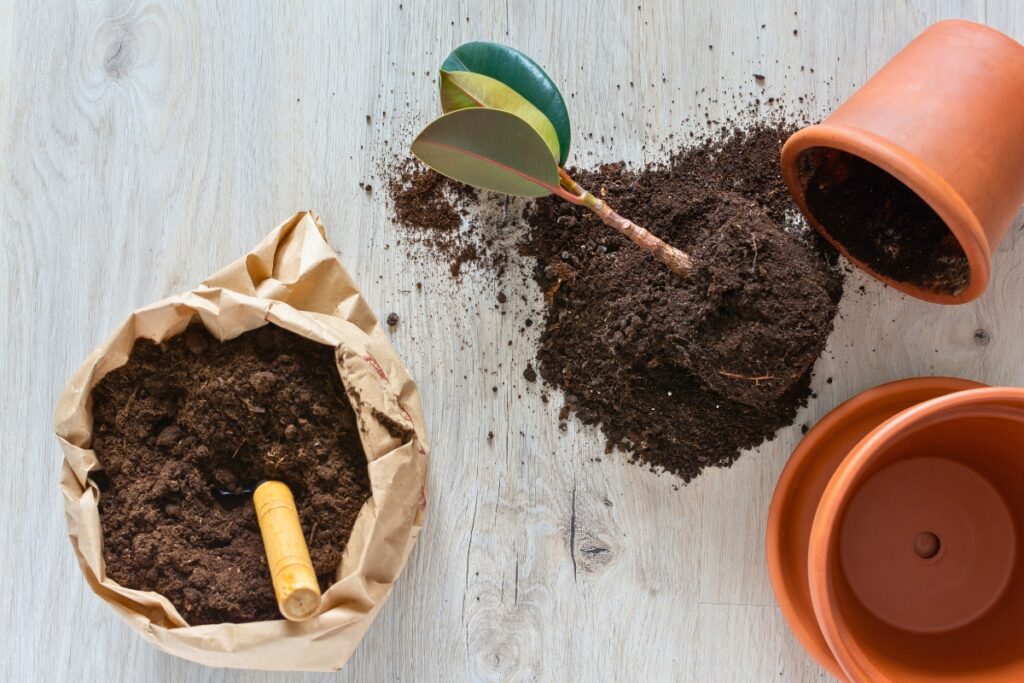You’ve probably noticed your rubber plant isn’t thriving like those Instagram-worthy specimens, and the secret often lies right in the pot. While these resilient plants can tolerate various conditions, they won’t reach their full potential without the right soil mix. Getting this foundation right means understanding exactly what makes these tropical beauties tick, from their need for perfect drainage to their appetite for specific nutrients. Let’s uncover how to create their ideal growing environment.

Contents
Understanding Rubber Plant Soil Requirements
Rubber plants (Ficus elastica) require well-draining, nutrient-rich soil that retains adequate moisture while preventing waterlogging. The ideal soil mix should have a pH between 6.0 and 7.0, combining organic matter with materials that promote proper drainage and aeration around the root system.
The soil structure needs to strike a balance between water retention and drainage capability. A mix that’s too dense can lead to root rot, while an overly loose medium might dry out too quickly. Rubber plants thrive in soil that contains a combination of elements such as peat moss for moisture retention, perlite or coarse sand for drainage, and organic compost or loam for nutrient content.
Essential Components of the Perfect Soil Mix
The perfect soil mix for rubber plants requires a careful balance of essential components that promote both drainage and moisture retention. The foundation should consist of high-quality potting soil, which provides necessary nutrients and structure. This base needs to be amended with materials like perlite or pumice (20-30%) to enhance aeration and prevent soil compaction, while coarse sand (10-15%) helps with drainage.
Organic matter in the form of peat moss or coco coir (20-25%) is vital for moisture retention and maintaining soil structure. These components help create air pockets while holding enough water for the rubber plant’s roots. Additional organic materials like composted bark or worm castings (10-15%) enrich the mix with slow-release nutrients and beneficial microorganisms, supporting long-term plant health.
DIY Rubber Plant Potting Mix Recipe
A well-balanced DIY rubber plant potting mix consists of three main components mixed in equal parts: regular potting soil, peat moss, and perlite. The potting soil provides essential nutrients and structure, peat moss helps retain moisture while remaining light and airy, and perlite guarantees proper drainage and prevents soil compaction.
To create the mix, combine 1 part potting soil, 1 part peat moss, and 1 part perlite in a large container or wheelbarrow. Mix thoroughly until all components are evenly distributed. For additional nutrients and improved drainage, you can add a small amount of orchid bark or coconut coir. Some growers also incorporate a handful of worm castings or slow-release fertilizer pellets to provide sustained nutrition for the rubber plant.
Signs Your Rubber Plant Needs Fresh Soil
Signs that indicate your rubber plant needs fresh soil include yellowing or dropping leaves, slowed growth, and soil that appears compacted or water-repellent. When the soil becomes depleted of nutrients or breaks down over time, the plant will show visible stress signals, and the root system may become visible at the soil surface or through drainage holes.
Another clear indicator is when water runs straight through the pot without being absorbed, or alternatively, when water sits on top of the soil for too long without draining. If you notice a white crust forming on the soil surface, this typically indicates salt build-up from fertilizers, suggesting it’s time for fresh soil. Additionally, if your rubber plant hasn’t been repotted in 2-3 years, the soil has likely lost its nutritional value and structure.
Best Commercial Soil Brands for Rubber Plants
Commercial potting mixes specifically formulated for indoor tropical plants work well for rubber plants, with several trusted brands leading the market. Fox Farm Ocean Forest, Miracle-Gro Indoor Potting Mix, and Black Gold All Purpose Potting Soil consistently receive high ratings from rubber plant enthusiasts. These brands provide the well-draining, nutrient-rich foundation that rubber plants need to thrive.
Back To The Roots and Espoma Organic Potting Mix are also excellent choices, as they contain beneficial mycorrhizae and proper ratios of organic materials. These premium soil brands typically include a balanced blend of peat moss, perlite, vermiculite, and composted materials that help maintain ideal moisture levels while preventing soil compaction. When selecting a commercial brand, look for those that advertise good drainage and aeration properties, as rubber plants are susceptible to root rot in heavy, waterlogged soils.
How to Successfully Repot With the Right Soil
Repotting a rubber plant with the right soil mix begins with timing and preparation. The best time to repot is during the growing season (spring or early summer), when the plant is actively growing and can recover quickly from transplant stress. Before repotting, prepare a container with drainage holes that’s 1-2 inches larger than the current pot and gather fresh, well-draining potting mix.
The repotting process involves carefully removing the rubber plant from its current container, gently loosening the root ball, and removing any dead or rotting roots. Place a layer of fresh soil mix in the new pot, position the plant at the same depth it was growing previously, and fill around the roots with the soil mixture, tamping down gently to remove air pockets. After repotting, water thoroughly and place the plant in a location with indirect light until it shows signs of new growth.
